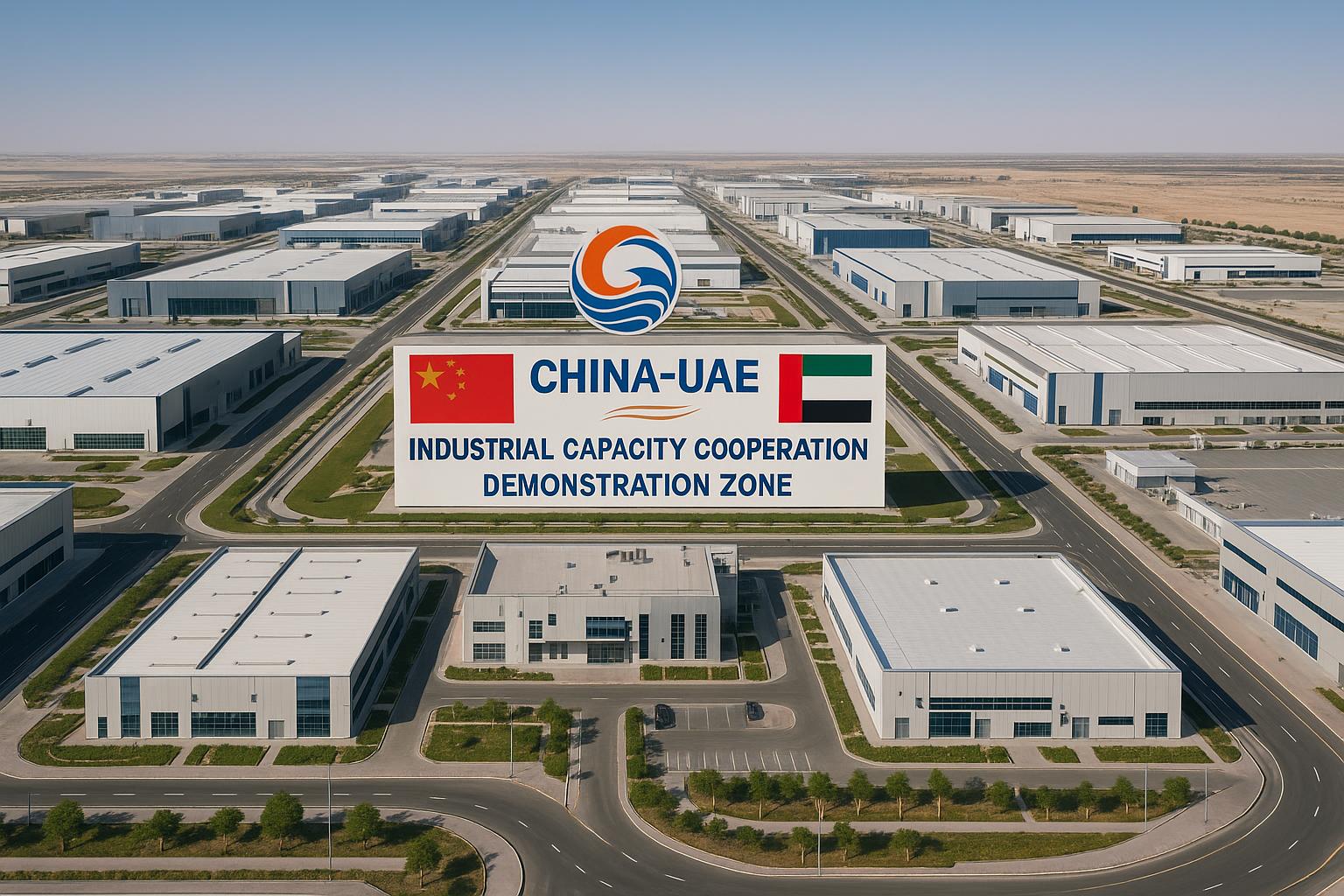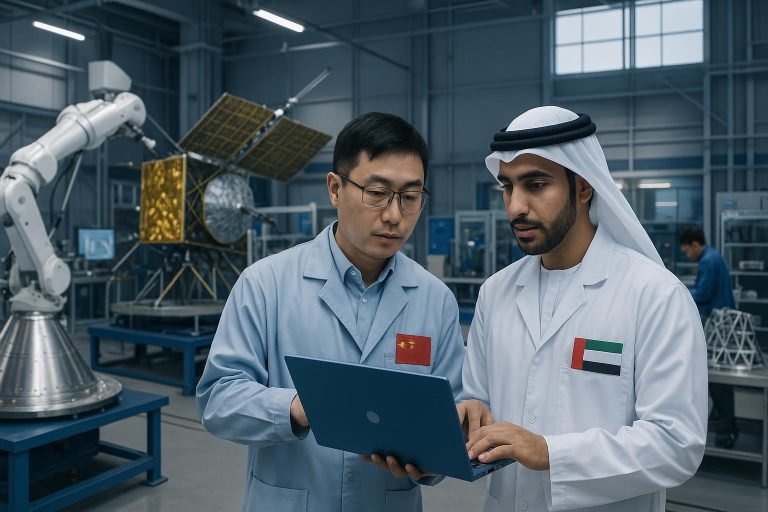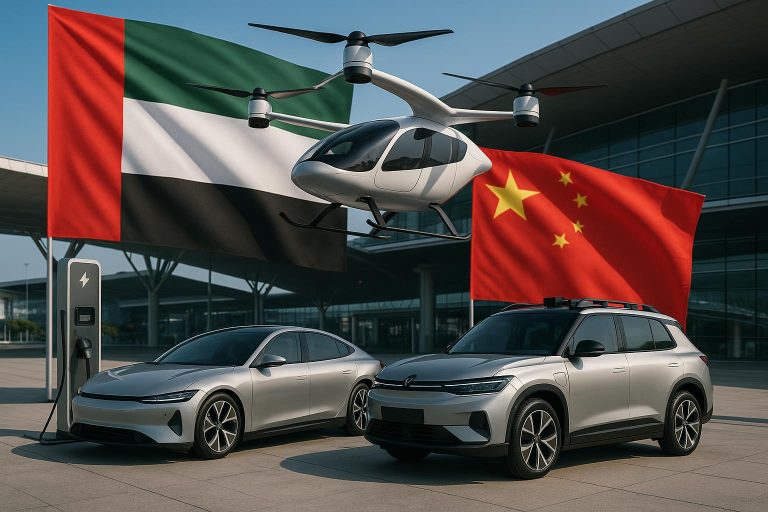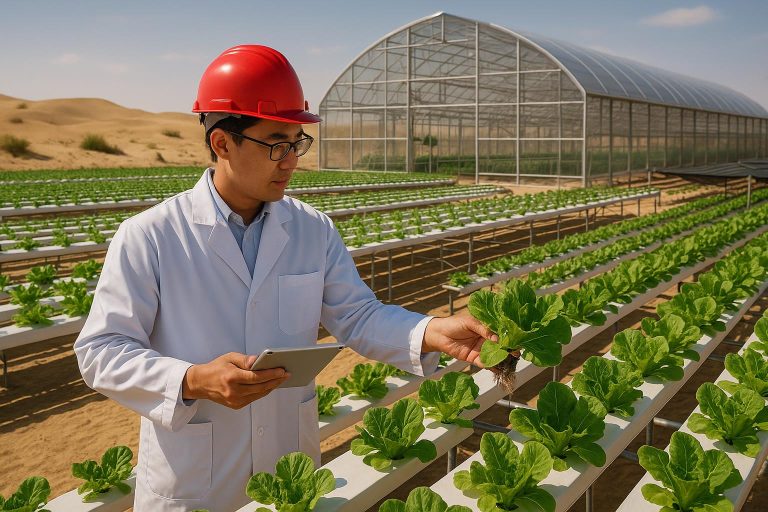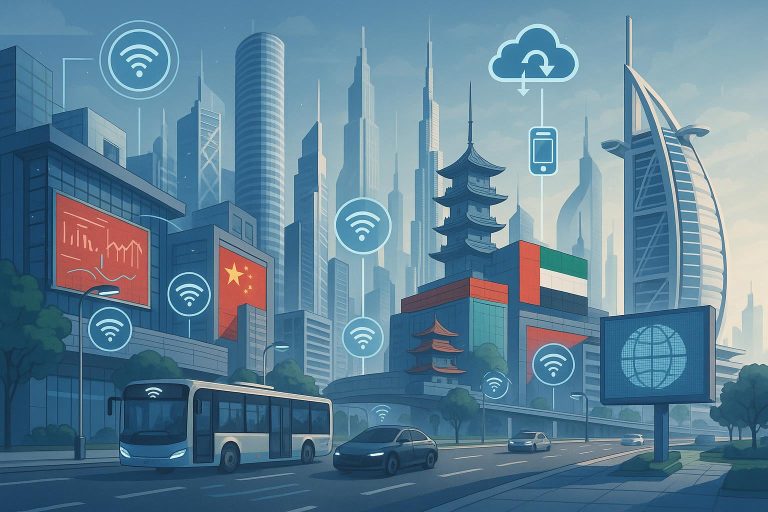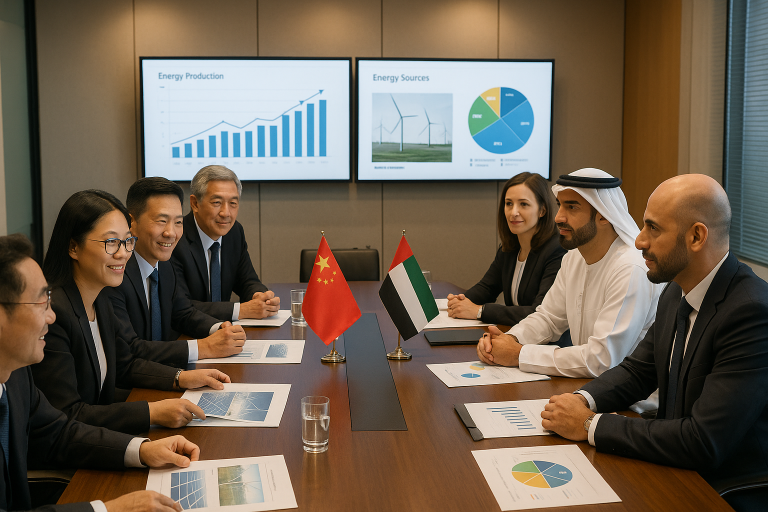The BRI’s Crown Jewel: A Case Study of the China-UAE Industrial Capacity Cooperation Demonstration Zone (ICCDZ)
Executive Summary
The China-UAE Industrial Capacity Cooperation Demonstration Zone (ICCDZ) stands as a pivotal achievement within China’s Belt and Road Initiative (BRI), symbolizing the deepening comprehensive strategic partnership between the United Arab Emirates and China. This article examines the ICCDZ as a prime example of successful bilateral investment and industrial collaboration, set against a backdrop of record-breaking trade volumes exceeding $101.8 billion in 2024 and significant UAE investments in China. While highlighting the immense opportunities for strategic growth, particularly in sectors like energy, infrastructure, and technology, it also critically assesses the challenges inherent in such large-scale international ventures. The ICCDZ not only reinforces the UAE’s role as China’s gateway to the Middle East but also offers a blueprint for future industrial capacity cooperation, fostering economic diversification and mutual prosperity, albeit requiring continuous adaptation to geopolitical shifts and evolving economic landscapes. This analysis provides insights into its current impact and future potential, offering strategic recommendations for sustained success.
Introduction
The relationship between the United Arab Emirates (UAE) and China has evolved into a comprehensive strategic partnership, marked by robust economic ties and burgeoning cooperation across diverse sectors. At the heart of this deepening alliance lies the Belt and Road Initiative (BRI), China’s ambitious global infrastructure development strategy. Within this framework, the China-UAE Industrial Capacity Cooperation Demonstration Zone (ICCDZ) emerges as a flagship project, embodying the spirit of mutual growth and shared prosperity. This article delves into the ICCDZ as a critical case study, illustrating the profound impact of industrial capacity collaboration on bilateral investment and economic diversification.
Over the past decades, the bilateral trade volume has witnessed an extraordinary surge, reaching a record $101.8 billion in 2024, an 800-fold increase since 1984. This remarkable growth underscores the UAE’s strategic importance as China’s largest export market in the Middle East and its second-largest trading partner in the region, while China consistently remains the UAE’s foremost trading partner. The presence of over 15,000 Chinese firms operating in the UAE further solidifies this economic interdependence. Against this backdrop, the ICCDZ represents a strategic nexus, designed to leverage the strengths of both nations to foster innovation, industrial development, and sustainable economic growth, thereby serving as a ‘crown jewel’ of the BRI in the Gulf region.
The Current Landscape of Bilateral Cooperation
The economic and strategic relationship between the UAE and China has witnessed an unprecedented trajectory of growth, culminating in a comprehensive strategic partnership established in 2018. This framework has fostered an environment conducive to robust bilateral investment and trade, positioning both nations as indispensable partners in the global economic landscape. The sheer scale of this cooperation is evident in the trade figures: bilateral trade volume soared to a record $101.8 billion in 2024, marking an astonishing 800-fold increase since 1984. This makes the UAE China’s largest export market in the Middle East and its second-largest trading partner in the region, while China consistently holds its position as the UAE’s primary trading partner. The presence of over 15,000 Chinese firms operating within the UAE further underscores the depth of this economic integration, complemented by a significant increase in UAE investments in China, which reached $4.5 billion by the end of 2023, a 96% rise from the previous year.
Beyond trade, the strategic partnership is reinforced by regular high-level diplomatic engagements and the establishment of dedicated mechanisms such as the UAE-China Investment and Economic Cooperation Working Group. These platforms facilitate dialogue and agreement on critical areas of mutual interest, extending cooperation across a multitude of sectors. Key among these are Energy & Clean Energy, where investments in solar and wind power are prominent, exemplified by the Masdar-China Silk Road Fund MoU for renewable energy projects within BRI countries. Infrastructure & Logistics form another cornerstone, with projects like the COSCO terminal at Khalifa Port and the China-UAE Industrial Capacity Zone solidifying the UAE’s role as China’s gateway to the Gulf.
Technology & AI cooperation is rapidly expanding, driven by technology cooperation agreements and digital transformation initiatives. Similarly, Trade & Free Zones benefit from strong partnerships, such as JAFZA’s collaborations with Chinese free trade zones and DP World’s extensive network. Finance & Investment are pivotal, with significant contributions from Belt and Road Initiative projects totaling $3.1 billion in the UAE, alongside cross-border investment facilitation. Recent developments (2024-2025) highlight a focus on new economy sectors, entrepreneurship, tourism, and aviation, marked by multiple MoUs and high-level visits.
Further diversification is observed in Healthcare & Pharmaceuticals, with UAE entities like Mubadala acquiring significant stakes in Chinese pharmaceutical businesses, and collaborations spanning medical technology and biotech. Agriculture & Food Security initiatives, such as the $33 million smart agricultural project between Silal and China’s Shouguang Vegetable Group, demonstrate a commitment to modern farming techniques. In Aviation & Transportation, deals like the $1 billion agreement for 350 flying taxis and Emirates’ expanded network in China signify robust growth. Logistics & Supply Chain are enhanced by ventures like JINGDONG Property’s Middle East logistics hub in Dubai, leveraging smart supply chain technologies. Finally, Artificial Intelligence & Digital Transformation are central to the $5 billion partnership between the UAE and China, with entities like G42 playing a strategic role in AI investments, and Tourism & Hospitality and Financial Services & Fintech also seeing increased collaboration and investment, underscoring the multifaceted and dynamic nature of the bilateral relationship.
Opportunities and Strategic Growth Drivers
The China-UAE Industrial Capacity Cooperation Demonstration Zone (ICCDZ) is strategically positioned to capitalize on numerous opportunities and act as a significant driver for growth within the broader bilateral relationship. The foundational strength of this partnership, underpinned by the Belt and Road Initiative (BRI), provides a robust platform for sustained economic expansion and diversification for both nations. The UAE, with its advanced infrastructure, strategic geographic location, and business-friendly environment, serves as an ideal hub for Chinese enterprises seeking to expand their reach into the Middle East, Africa, and Europe.
One of the primary growth drivers is the continued expansion of Infrastructure & Logistics. The ICCDZ, alongside projects like the COSCO terminal at Khalifa Port, enhances the UAE’s role as a critical logistics and trade gateway. This synergy facilitates smoother supply chains and reduces transit times, making the UAE an attractive base for manufacturing and distribution. The recent establishment of JINGDONG Property’s first Middle East logistics hub in Dubai further exemplifies this trend, integrating smart supply chain technologies that benefit both Chinese and regional markets.
Energy & Clean Energy represent another substantial area for growth. The UAE’s ambitious renewable energy targets align perfectly with China’s expertise and investment capacity. Collaborations such as the Masdar-China Silk Road Fund MoU are paving the way for significant investments in solar and wind power projects, not only within the UAE but also across other BRI countries. This cooperation supports the UAE’s economic diversification away from hydrocarbons and contributes to global sustainability efforts.
Technology & AI are emerging as pivotal sectors for future growth. The $5 billion partnership between the UAE and China focusing on AI, renewable energy, and infrastructure highlights a shared vision for a digitally advanced future. UAE entities like G42 are strategically positioned to leverage Chinese technological advancements, while initiatives like Digital Dubai exploring AI and smart city technologies in Shenzhen underscore a proactive approach to digital transformation. This collaboration fosters innovation, knowledge transfer, and the development of cutting-edge industries.
Furthermore, the increasing focus on Healthcare & Pharmaceuticals and Agriculture & Food Security presents untapped potential. UAE’s Mubadala’s acquisition in China’s pharmaceutical sector and the $33 million smart agricultural project between Silal and China’s Shouguang Vegetable Group demonstrate a mutual commitment to addressing critical societal needs through advanced technology and investment. These sectors not only promise economic returns but also contribute to national resilience and well-being.
Finally, the robust growth in Tourism & Hospitality and Financial Services & Fintech further solidifies the strategic drivers. With initiatives like the 2025 China-GCC tourism trade fair in Dubai and cross-border payment cooperation between China’s CIPS and the UAE central bank, both nations are actively fostering environments for increased capital flow and people-to-people exchanges. The ICCDZ, by attracting industrial investment, indirectly supports these sectors through increased business travel, expatriate communities, and demand for financial services, creating a holistic ecosystem of growth and opportunity.
Challenges and Critical Considerations
While the China-UAE Industrial Capacity Cooperation Demonstration Zone (ICCDZ) and the broader bilateral relationship present significant opportunities, it is imperative to acknowledge and address potential challenges and critical considerations to ensure sustained success. One primary concern revolves around geopolitical dynamics and regional stability. The Middle East is a complex region, and shifts in international relations or regional conflicts could impact investment flows, supply chains, and the overall operational environment for the ICCDZ. Maintaining a stable and predictable political landscape is crucial for attracting and retaining foreign direct investment.
Another critical aspect is regulatory harmonization and legal frameworks. While both the UAE and China have made strides in creating investor-friendly environments, differences in legal systems, business practices, and regulatory compliance can pose hurdles. Continuous dialogue and efforts to streamline processes, ensure transparency, and protect intellectual property rights are essential for fostering trust and reducing operational complexities for businesses operating within the zone.
Cultural integration and human resource management also warrant attention. The influx of diverse workforces requires effective strategies for cultural understanding, talent development, and ensuring equitable labor practices. Bridging cultural gaps and fostering an inclusive environment are vital for productivity and long-term sustainability. Furthermore, competition from other regional industrial hubs and free zones necessitates continuous innovation and differentiation for the ICCDZ to maintain its competitive edge. The zone must consistently offer compelling incentives, advanced infrastructure, and specialized services to attract high-value industries.
Finally, global economic uncertainties and market fluctuations can impact demand for manufactured goods and services, affecting the profitability and expansion plans of enterprises within the ICCDZ. A proactive approach to risk management, economic diversification within the zone, and adaptability to evolving global trade patterns will be crucial for navigating these external pressures. Addressing these challenges head-on with strategic foresight and collaborative solutions will be key to realizing the full potential of the ICCDZ as a model for international industrial cooperation.
Case Study Spotlight: The China-UAE Industrial Capacity Cooperation Demonstration Zone (ICCDZ)
The China-UAE Industrial Capacity Cooperation Demonstration Zone (ICCDZ), located within Khalifa Port Free Trade Zone (KIZAD) in Abu Dhabi, stands as a tangible embodiment of the Belt and Road Initiative’s success in the Middle East. Conceived as a strategic platform for Chinese enterprises to establish manufacturing bases and expand into regional markets, the ICCDZ facilitates industrial transfer and capacity cooperation across various sectors. It represents a significant portion of the $3.1 billion in BRI projects within the UAE, attracting substantial investment and fostering job creation.
The zone offers state-of-the-art infrastructure, streamlined regulatory processes, and access to global shipping routes, leveraging the UAE’s logistical prowess. Companies operating within the ICCDZ benefit from a favorable business environment, including tax incentives and full foreign ownership, making it an attractive destination for high-tech manufacturing, new energy, and advanced materials industries. The ICCDZ not only strengthens the UAE’s industrial base and economic diversification efforts but also provides Chinese companies with a strategic foothold to serve the wider MENA region, showcasing a successful model of international industrial collaboration and mutual economic benefit.
Future Outlook and Strategic Recommendations
The future trajectory of the China-UAE bilateral relationship, particularly through the lens of the ICCDZ, appears robust and promising, poised for continued expansion and diversification. The strategic alignment between China’s Belt and Road Initiative and the UAE’s economic diversification agenda provides a fertile ground for sustained collaboration. Looking ahead, the ICCDZ is expected to further solidify its role as a critical hub for advanced manufacturing, technological innovation, and logistics, attracting more high-value industries and contributing significantly to the UAE’s non-oil GDP.
To maximize this potential, several strategic recommendations emerge. Firstly, deepening technological collaboration, especially in AI, digital transformation, and advanced manufacturing, is paramount. Leveraging Chinese expertise in these areas while fostering local talent development within the ICCDZ can create a synergistic ecosystem. Secondly, enhancing regulatory frameworks and investment protection will further de-risk investments and attract a broader spectrum of international enterprises. Simplifying administrative procedures and ensuring legal predictability will be key. Thirdly, focusing on sustainable development and green technologies within the zone, particularly in clean energy, aligns with global environmental goals and the UAE’s commitment to a sustainable future. Finally, promoting cultural exchange and human capital development will ensure a harmonious and productive environment for the diverse workforce, fostering long-term partnerships and mutual understanding. By proactively addressing challenges and strategically leveraging opportunities, the ICCDZ can continue to shine as a crown jewel of the BRI, driving mutual prosperity and innovation for both China and the UAE.
Conclusion
The China-UAE Industrial Capacity Cooperation Demonstration Zone (ICCDZ) serves as a powerful testament to the strategic depth and economic vitality of the bilateral relationship between the UAE and China. As a flagship project of the Belt and Road Initiative, it has not only facilitated significant industrial transfer and investment but has also become a catalyst for the UAE’s economic diversification and a strategic gateway for Chinese enterprises into broader regional markets. The remarkable growth in bilateral trade, the extensive presence of Chinese firms, and the increasing UAE investments in China underscore a partnership built on mutual benefit and shared strategic objectives. While challenges related to geopolitical shifts, regulatory harmonization, and global economic uncertainties persist, the proactive and collaborative approach adopted by both nations positions the ICCDZ for continued success. By focusing on technological advancement, sustainable development, and human capital, the ICCDZ is poised to remain a shining example of international industrial cooperation, contributing significantly to the prosperity and innovation of both the UAE and China.
References
[1] Bilateral trade statistics and investment data from official government reports and economic analyses (e.g., UAE Ministry of Economy, China Ministry of Commerce).
[2] Reports and press releases from the China-UAE Industrial Capacity Cooperation Demonstration Zone (ICCDZ) and Khalifa Port Free Trade Zone (KIZAD).
[3] News articles and analyses from reputable financial and economic news outlets covering China-UAE relations and the Belt and Road Initiative.
[4] Official statements and joint communiques from high-level diplomatic engagements between the UAE and China. [
5] Corporate announcements and annual reports from companies involved in key cooperation sectors (e.g., Masdar, COSCO, Mubadala, Silal, JINGDONG Property, G42).

